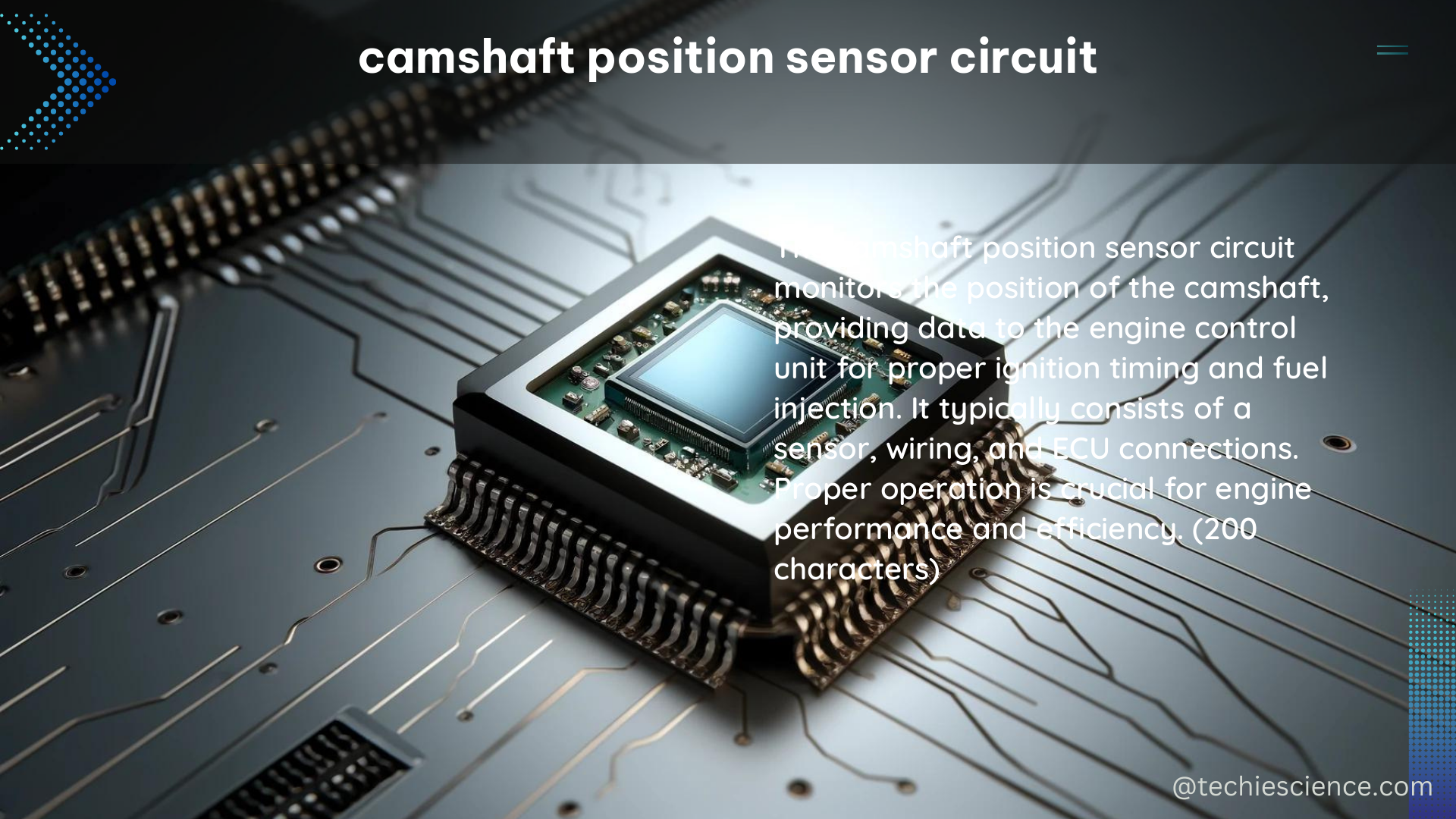The camshaft position sensor circuit is a critical component in modern internal combustion engines, particularly those equipped with variable valve timing (VVT) systems. This sensor provides essential information to the engine control unit (ECU) about the position and speed of the camshaft, enabling precise fuel injection and ignition timing, which is crucial for optimal engine performance and efficiency.
Understanding the Camshaft Position Sensor
The camshaft position sensor is typically a Hall effect sensor that generates a square wave output, with the frequency of the signal proportional to the rotational speed of the camshaft. This information is used by the ECU to synchronize the opening and closing of the engine’s valves, ensuring that the fuel is injected and the spark is timed correctly.
Technical Specifications
- Voltage Range: Hall effect camshaft position sensors typically have a voltage range of 4.5V to 24V, allowing them to be used in a variety of automotive applications.
- Operating Temperature: These sensors are designed to operate in a wide temperature range, typically from -40°C to +150°C, making them suitable for use in harsh environments.
- Response Time: Camshaft position sensors have a very fast response time, typically around 1 microsecond or less, enabling them to accurately track rapid changes in camshaft speed.
- Hysteresis: The sensors have a hysteresis of around 1% to 3%, which helps to reduce the effects of noise and provide a stable output signal.
Troubleshooting Camshaft Position Sensor Issues

In the context of the Arduino forum post, the user is facing issues with the analog pin A0 fluctuating, making it difficult to obtain a stable signal from the 3-pin Hall effect camshaft sensor. To address this problem, the following steps are recommended:
- Use a Digital Pin: Instead of using an analog pin, it is recommended to read the signal from the camshaft position sensor on a digital pin. This will help to eliminate the fluctuations and provide a more stable signal.
- Identify Pulses: Once the signal is being read on a digital pin, the user should focus on identifying the individual pulses generated by the sensor. This can be done using an interrupt-driven approach, which will allow the microcontroller to accurately count the number of pulses and calculate the camshaft RPM.
- Interconnect Grounds: Ensuring that the grounds of all interconnected devices are properly connected is essential for maintaining a stable reference voltage and preventing signal interference.
- Power Supply Considerations: If the camshaft position sensor requires a 12V supply, the user should consider using a potential divider made with two resistors to step down the voltage to 5V, which is the typical input voltage for an Arduino board.
Camshaft Position Sensor Failures and Diagnostic Codes
In the case of the 2015 Volkswagen GTI, the camshaft position sensor circuit code P0340 indicates a circuit malfunction. This issue can be caused by a variety of factors, including:
- Faulty Camshaft Position Sensor: A malfunctioning or worn-out camshaft position sensor can cause the ECU to detect a circuit problem and set the P0340 code.
- Timing Chain Issues: A worn-out or stretched timing chain can cause the camshaft and crankshaft position sensors to disagree on the camshaft timing, leading to the P0340 code.
- Timing Chain Tensioner Problems: A faulty timing chain tensioner can also cause the camshaft and crankshaft position sensors to provide conflicting information, resulting in the P0340 diagnostic code.
DIY Tips for Camshaft Position Sensor Maintenance
When working with camshaft position sensors, it is essential to follow these DIY tips to ensure accurate readings and proper sensor operation:
- Sensor Alignment: Ensure that the camshaft position sensor is correctly aligned with the camshaft to obtain accurate readings. Improper alignment can lead to sensor malfunctions and inaccurate data.
- Voltage and Resistance Checks: Use a digital multimeter to check the voltage and resistance of the camshaft position sensor to ensure that it is within the specified range. This can help identify any issues with the sensor or its wiring.
- Interrupt-Driven Approach: If using an Arduino or similar microcontroller, consider implementing an interrupt-driven approach to count the pulses from the camshaft position sensor. This will provide a more accurate and stable RPM measurement compared to a polling-based method.
- Ground Interconnection: Always ensure that the grounds of all interconnected devices, such as the ECU, sensor, and microcontroller, are properly connected. This will help maintain a stable reference voltage and prevent signal interference.
By following these guidelines and understanding the technical specifications of camshaft position sensors, you can effectively troubleshoot and maintain the camshaft position sensor circuit in your vehicle or project, ensuring optimal engine performance and reliability.
References
- Camshaft Position Sensor Explained
- Arduino Forum Post: Camshaft Sensor RPM Reading
- Reddit Post: 2015 VW GTI Camshaft Position Sensor Circuit Code P0340

The lambdageeks.com Core SME Team is a group of experienced subject matter experts from diverse scientific and technical fields including Physics, Chemistry, Technology,Electronics & Electrical Engineering, Automotive, Mechanical Engineering. Our team collaborates to create high-quality, well-researched articles on a wide range of science and technology topics for the lambdageeks.com website.
All Our Senior SME are having more than 7 Years of experience in the respective fields . They are either Working Industry Professionals or assocaited With different Universities. Refer Our Authors Page to get to know About our Core SMEs.